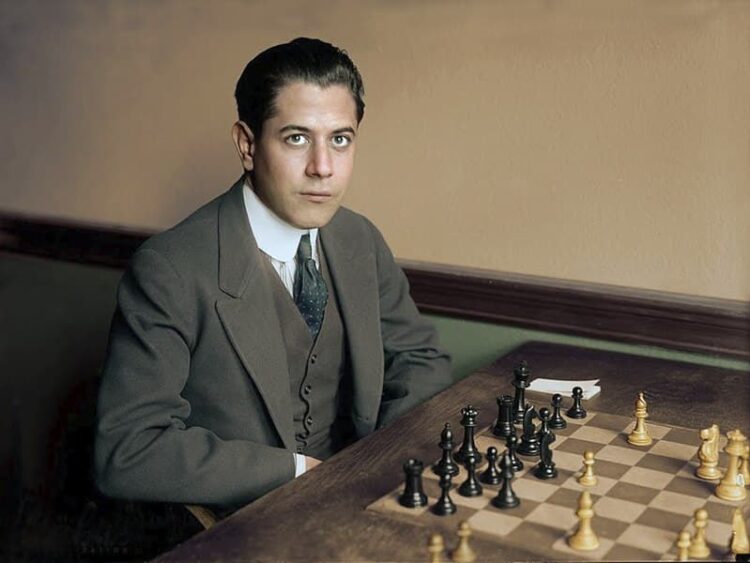Jose Raul Capablanca was a Cuban Chess prodigy that would grow to become World Champion from 1921 to 1927, and is one of the most studied players in the history of Chess. Even though FIDE didn’t exist back then, he would have the Grandmaster title of course. Furthermore, he is known as one of the best Chess players of all time. to the entire Chess community, which is significant considering how many Chess players are in the world. For more information on FIDE ratings, see the step-by-step guide on how to get a FIDE rating.
Full Name: Jose Raul Capablanca
Birth Date: Nov 19th, 1888
Birth Place: Cuba
Died: March 8th, 1942
Profiles
Jose Raul Capablanca was a Cuban chess player born on November 19th, 1988 in Havana Cuba. He held the World Chess Championship title from the year 1921 to 1927. Raul Capablanca is greatly known for his unique skills in the endgame as well as his playing speed.
Early Childhood
The child prodigy, Jose Capablanca grew up watching his father who was a soldier playing chess. By age of four, he had learned all rules of playing chess. He had mastered even the forbidden moves which enabled him to win against his father two times.
At only the age of 14, he had his first victory by dethroning the reigning champion in Cuba namely Juan Corzo. By the year 1905, Capablanca had joined the chess club of Manhattan. where he was announced as the best player in the club, particularly in fast chess tournaments.
In 1908, Capablanca moved to New York to study. It then appeared that he loved chess more than studying therefore he dropped schooling to pursue chess game full time. In the year 1909, Capablanca won against US undefeated champion Marshal Frank hence having eight wins against Marshal’s one win.
Achievements
Chess contender for the World Title
In 1911, the child prodigy had a breakthrough into the world’s best chess player when he attained the San Sabastian chess tournament beating all the world’s best chess players apart from Emanuel Lasker. The match between Lasker and Raul Capablanca did not take place since Capablanca had objections to game conditions that favored Lasker.
During this tournament, the contender Bernstein Ossip and NImzowitch Aron complained about Capablanca’s entry to the tournament while he had not met the chess requirements of at least attaining the second position in two advanced tournament prices. Even under such pressure, Capablanca easily won against Bernstein with only one round and more brilliantly against Akiba Rubenstein.
Capablanca had attained financial fulfillment by the year 1913 when he was employed in the foreign offices of Cuba. This was mainly because of his cheerful and charming character. This job facilitated his chess career as he was permitted to travel across Europe for chess tournaments mainly because had no specific tasks in the diplomatic offices but represented the Cubans in the world chess tournaments.
The year 1914 saw Capablanca participate in the first World Chess Championship in St. Petersburg. The main contender in this tournament was his long-life rival, Emanuel Lasker. The tournament was conducted in fair conditions for both of them. This tournament was prepared uniquely. There were round preliminaries tournament of eleven players and the best five players were to play in the second stage which was arranged to be a double round and points of both the first and second round were to be added together. Capablanca easily won in the first round against Lasker but in the second round, Lasker managed to trap Capablanca and Lasker finished the second round ahead of Capablanca with 3.5 points.
Capablanca signed another world championship with Alaska in the year 1920 and the championship took place in the year 1921 March-April where he won against Lasker as he was 20 years younger and had more vigorous updated practice. In the 1924 tournament with Lasker in New York, he finished first with 14/20(10+1) =9Points behind Alaskawith’s score of 1.5. At the end of this tournament, Capablanca finished was undefeated with 2.5 points ahead of every rival. He won the prize for the best game.
Capablanca’s Title losing
Since the 1921-word chess Championship, Capablanca had never lost a match even though he won the New York tournament with lots of struggle due to tough competition from Alexander Alekhine, who Capablanca lost his title to in the World Chess Championships in 1927. This match was held in Bueno Aires where Alekhine won against Capablanca by 25 draws, 3 losses, and 6 wins. This was the world’s longest chess tournament until 1985.
Even after defeating Capablanca, Alekhine confessed his victory against Capablanca was a surprise since he regarded Capablanca as the best chess player in the world He further opted that Casablanca’s overconfidence was what led to his losses as he did not prepare himself both technically and physically as opposed to Alkhein who had put himself in good mental and physical state.
The unwillingness of Capablanca to fully concentrate was what led to his loss and committed many small mistakes. This marked the first chess tournament that Capablanca had not won easily. Since this was the only loss that caused a great setback in Capablanca’s chess career, depression set on him for what Ludek Pachamaregar as an unnecessary loss.
After Capablanca lost his match, Alekhine wanted to give Capablanca a second with the same terms Capablanca had set for Alekhine which simply was that, the amount the challenger was to pay amounted to USD 10,000 and more than half of it will be taken by the defending champion whether he wins or lose. Although the negotiations for the rematch continued, they were slow, and in most cases disagreement occurred when the agreement was almost due. The conflict between them made Alekhine request for even much participation fee in every match Capablanca showed up.
Later Life
Even at his old age of 66, Capablanca was a chess icon for many people especially when he scored fourth with only one point less than Moscow Championships Winner, Emanuel Lasker in 1935. In the year 1936, Raul Capablanca scored even a better position ahead of Botvinnik with one point. Both Botvinnik and Capablanca finished first in a match conducted a month later in the same year 1936.
The1936 tournaments were the only matches Capablanca toped above of Lasker. In his reighning times, Capablanca, was diagnosed with hypertension which greatly affected his performance in Chess tournaments. In 1938, Capablanca participated in the AVRO chess game which was aimed at selecting an elite to compete with Alekhine but he only finished at position 8 as his blood worsened during the AVRO tournament where he died towards the end of the match.
Notable Games
There are simply too many notable games of Capablanca to list on one page, but to mention one that illustrates a lesson perfectly is below. This game perfectly demonstrates why you shouldn’t just copy your opponents moves.
Copying your opponents moves can work, but only for a few moves due to this one tiny thing in Chess called, “check”.
Did you enjoy reading about Jose Raul Capablanca? If you did, you might be interesting in reading other player profiles such as Bobby Fischer, Daniil Dubov, and Hans Niemann.


